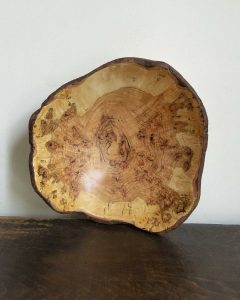In this post, we’ll explore the origins of wood burls and our famous burl wood bowls. We’ll discuss how burl wood is formed, what makes it so unique, and our own process of working with burl wood.

What is Burl Wood?
Burl wood is simply the material harvested from burls, which are formations that can be found on any tree species. You’ve likely seen these bulbous growths on trees before.
While burls might appear as an imperfection on a living tree, burl wood is notoriously hard to find and highly sought after for its unparalleled beauty. From these so-called imperfections, we create some of our most gorgeous bowls here at Spencer Peterman.
How Do Burls Form?
“A tree’s wood is also its memoir.” –Hope Jahren
Burls tell an important part of a tree’s story. They result from a stressor that causes irregular growth on the trunk, branches, or even roots of the tree. Injuries, viruses, and fungi can cause burls to form, as can insect or mold infestations. Severe weather events can lead to burls, and crowded root systems are susceptible to forming burls below ground. Because burls arise from environmental stressors, burl wood is often called “stress wood.”
However, once a burl forms, it is typically not an issue for the tree. In some cases, though, a very large and heavy burl stresses the tree and leaves it vulnerable to tipping over. Should a burl encompass the entire circumference of the tree trunk (also known as “girdling”), the burl could cut off the flow of water and nutrients to the rest of the tree, potentially killing it.
Why is Burl Wood So Unique?
You’ve probably heard the phrase “against the grain.” Wood grain runs in one direction, unless you’re talking about burl wood. In burls, there is no grain direction. Instead, the grain pattern is irregular and chaotic, full of swirls and waves. These gorgeous swirl and wave patterns are why burl wood is so valuable and desired.
Burl wood’s patterns make the material more challenging for woodworkers to work with in comparison to other wood. Without a grain direction, they are always working “against the grain”.
While burls might look like a terrible flaw from the outside, on the inside they are absolutely stunning. Burl wood is often used to add a decorative touch to furniture, instruments, and even high-end vehicles. (Did we mention burl wood bowls?).
Because it’s so rare and beautiful, burl wood is incredibly valuable, sometimes costing as much as $100 per board foot. This means a single burl, depending on its size, might be worth hundreds or even thousands of dollars.
Because of its high value, burl wood is sometimes poached–meaning the burl is removed from the tree while the tree is still alive. Removing a burl from a live tree can kill it, so if you are purchasing burl wood or burl wood products, ask about the origins of the wood to confirm that it was sustainably sourced.
Our Burl Wood Bowls
Not to worry, though–our burl wood bowls are always sustainably sourced, as is everything we make at Spencer Peterman.
In fact, we exclusively use locally and sustainably sourced wood for all of our products. Working with local tree services, we turn logs that would otherwise be chipped, burned, or tossed into boards, bowls, and tossers that will last a lifetime with the proper care.
Because we source our wood sustainably, and because burl wood is so hard to find, we can only offer our burl wood bowls when this rare material is available.
We’re currently offering Live Edge Oval Cherry Burl Wood Bowls, and soon will be offering Maple Burl Wood Bowls. Our burl wood bowls range in size from 10” to 21” in diameter.
We hope this post gives you insight into why we love working with this challenging but stunning wood, and why our burl wood bowls are so special.






